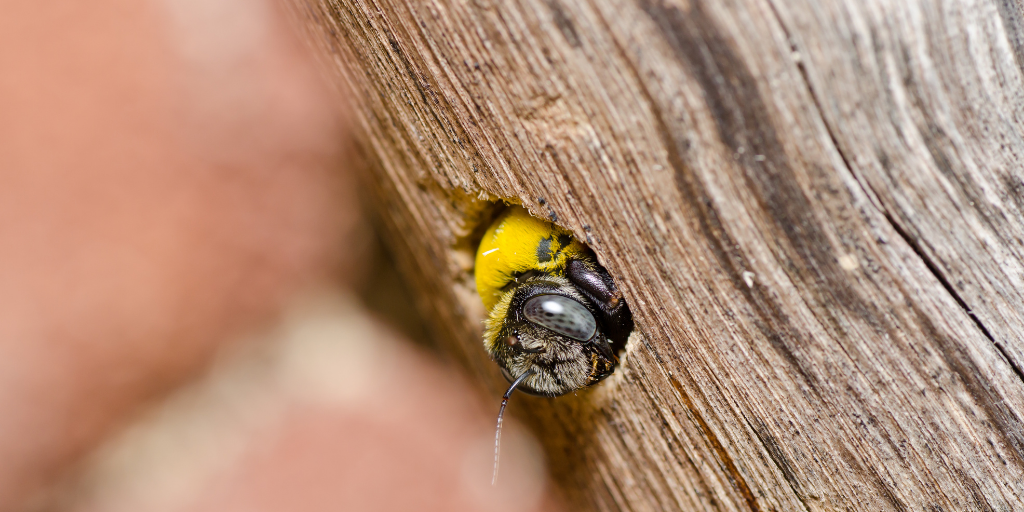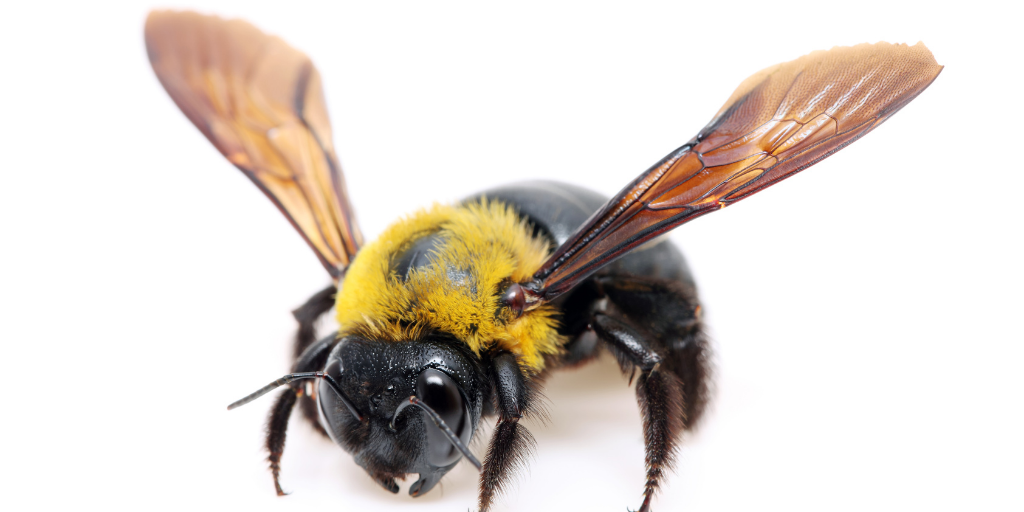PEST LIBRARY / BEES / CARPENTER BEES
Carpenter bees are not social and live in individual nests that they build in dry untreated wood, hence where they get their name. They nest most often outdoors in trees, tunnelling a circular hole 11 to 15mm into the wood that angles down slightly at the bottom, which is where female carpenter bees lay her eggs. While they do chew through the wood, they do not eat the wood. Their diet consists of nectar and plant pollen.

They are also known to build their nests on homes, businesses and other man-made structures that contain untreated wood, like frames, siding, eaves, fascia, decorative beams, decks, porches, railings, and even wooden lawn furniture. They especially love cedar (commonly used in decorative beams outside homes and businesses) because it is easy to bore into. They are considered a nuisance for homes, cottages, and businesses because their nesting causes structural or cosmetic damage. They are not as destructive as termites, but they can be responsible for substantial damage after years of infesting the same pieces of wood. Adult carpenter bees overwinter individually in their nests and they will reuse the same nest in the spring and continue to bore into it to enlarge it as needed. Over time, moisture will get into the wood, causing it to rot and decay. Carpenter bee feces also stains wood, also with pollen.
While carpenter bees resemble bumble bees, they are not as round and fuzzy looking. Carpenter bees are oval shaped and appear smooth and shiny. Their abdomens don’t have yellow markings, as the bumble bees species does. These bees are yellow or black and range from ¼ inch to 1 inch in length, with 6 legs and antennae. Only female carpenter bees have a stinger.

As their nests are often high up, they usually do not bother people, however when disturbed and agitated, males will buzz about aggressively, and females will sting if provoked. Their sting can be painful and, in some cases, could cause skin irritation or a more serious allergic reaction.
Carpenter bees, like bumble bees, pass through four stages - egg, larva, pupa and adult. It takes an average of 7 weeks for an egg to become an adult carpenter bee. An adult bumble bee can live up to 3 years. Both adult male and female carpenter bees overwinter, which is different from honey bees and bumble bees, where only fertilized females, destined to be future queens, overwinter.
The most common sign that you have a carpenter bee infestation is discovering their smooth, round hole in wood - their nests. Sometimes sawdust is found on the ground beneath where the nest is and was being built. With a carpenter bee infestation, it is common to see these insects flying around these nests. You may also notice pollen or bee feces stains near or around their nesting holes.
Using sealed, treated, and painted wood is a good deterrent, and can slow down carpenter bees. These insects prefer untreated, bare, weathered wood for nesting, so the less of this you have around your home, business, and property, the lower the chances they will nest.
Pest proofing your home and business is a good way to prevent these insects from getting inside and becoming a more serious nuisance. They commonly get indoors through tears in screens, windows without screens, and gaps in doors (which do not close properly. They can also get inside via cracks and crevices around windows, doors, and foundations.
If you discover that you have a carpenter bee infestation, or think you do, contact a carpenter bee expert like the team here at Environmental Pest Control. We’ve been providing professional and effective carpenter bee control since 1988.
NO RELIANCE ON PESTICIDE PRODUCTS - LEARN ABOUT OUR GREEN PEST MANAGEMENT SYSTEM